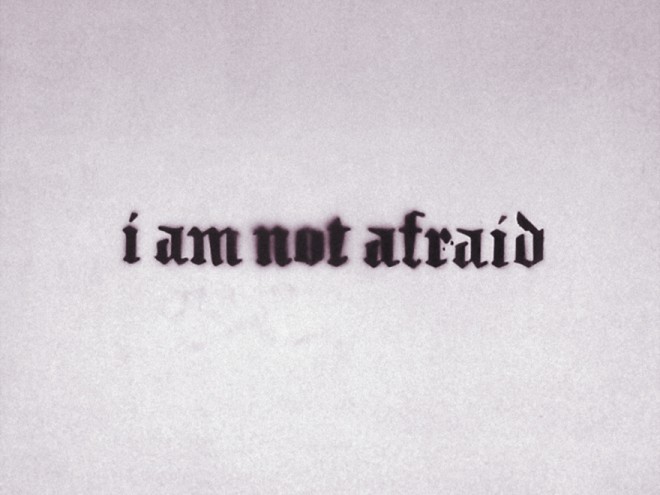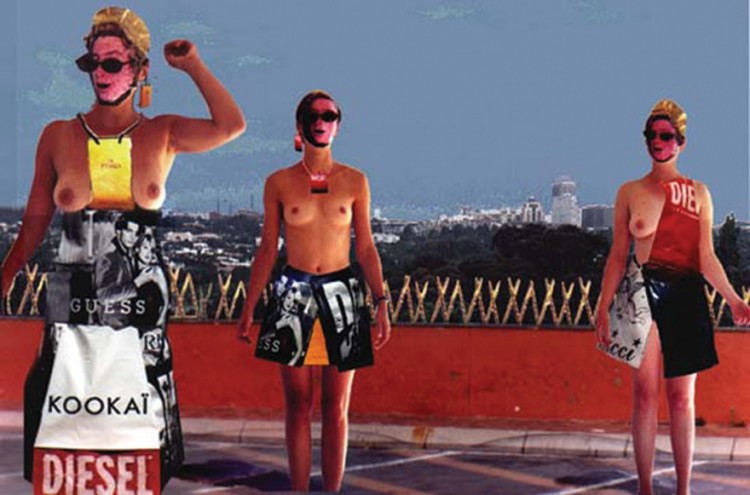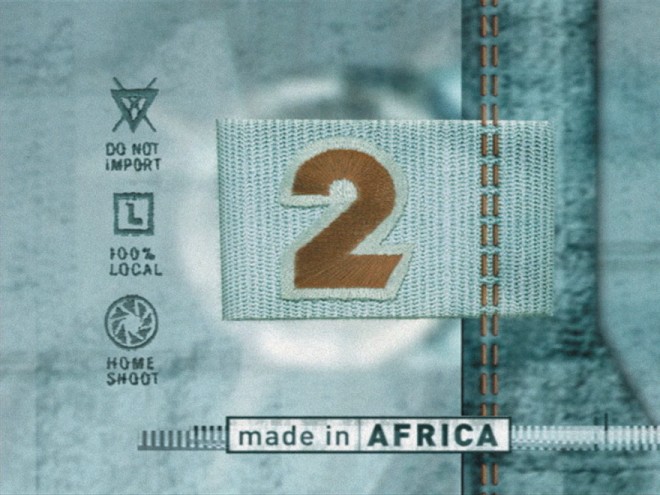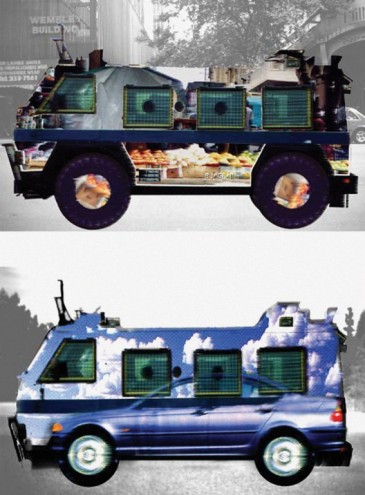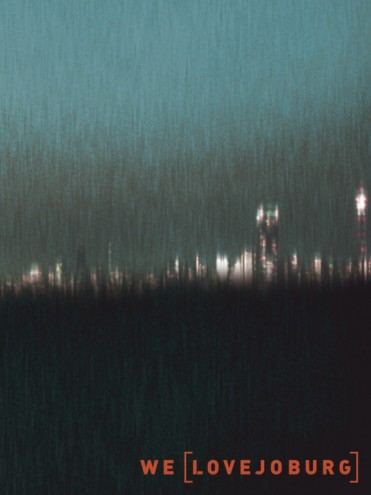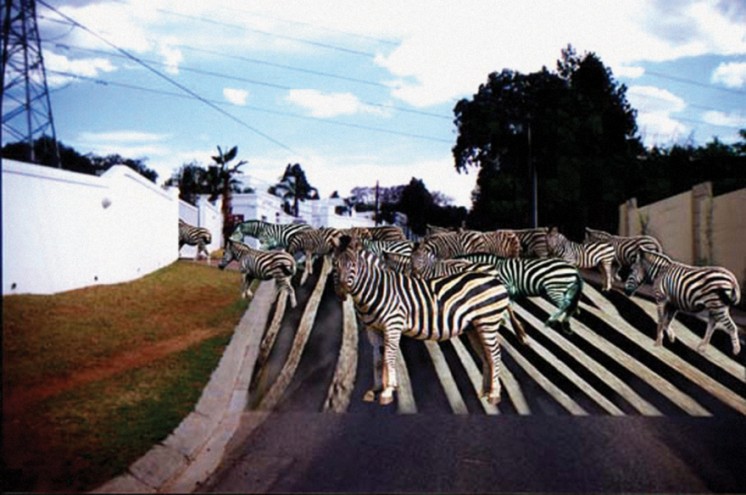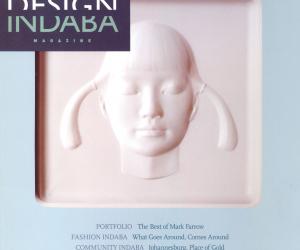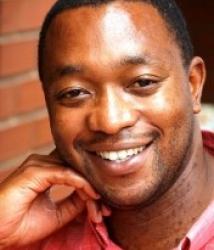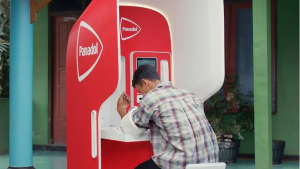First Published in
Johannesburg: Surely this is the very death place of creativity? What creative idea could germinate and take root in its concrete structures? What creative gem could be uncovered in the mine dumps dotting the physical landscape of the hub of Africa's economic activity? Rodney Place, Johan van Wyk and Muzi Kuzwayo, passionate Jo'burgers through and through, and eminently qualified to comment on the city, take a reluctant break to share their perspectives on what makes the great African metropolis city a living nerve centre in the creative body of South Africa. In the process, perhaps unintentionally, they reveal a surprisingly fragile, soft centre to the hard exterior the city sometimes presents.
Rodney Place
Retreks
There is no clear line between the "new" and "old" South Africa. What presently exists in South Africa are several, equal forces of mobility that are particularly interesting as they act on and continue to form metropolitan Johannesburg. Rather like Dallas/Fort Worth and the spread of Los Angeles, Metropolitan Johannesburg now stretches from Soweto to Pretoria and is not necessarily confined to the name of the CBD. I see Johannesburg in four identities based on clear images that have emerged since I arrived back in South Africa two years ago. They are by no means definitive, nor mutually exclusive, but are simply the parameters set up to begin the investigation into the identity of Johannesburg.
The Second Great Trek (South)
There is a convergence of immigrants from throughout the African continent, finding their place in Johannesburg. While the first Great Trek happened against a back-drop of harsh landscape and indigenous peoples, the second Great Trek is happening within a modern industrial city. Both Treks seemed to involve carts and the bringing of cultural habits and wares into an unfamiliar and somewhat deserted terrain, thereby changing things forever. Some might read what is happening now to central Johannesburg as the equivalent of the sack of Rome: disintegration and decline. But Johannesburg is becoming more complex with this new migration. It is a unique and exotic world city rather than a city based on simple vanities- that when the western world has modernism, so does it; when the western world has Helmut Jahn, so does it and all that is left to do is to keep it clean and well maintained. This publicists' view of culture is easy to act out as style, but is ultimately uninteresting. (The form of Rome itself is more compelling during periods of transition - Medieval Rome, Baroque Rome, and so on).
Kwa Sandton (An Anglostan)
When the British first encountered the Zulus in Natal, during the reign of Shaka, a dispatch was sent back to London claiming that, at last, the British had discovered a people as civilised as themselves. Both peoples seemed to have arrived at a point in the 19th Century where they had created national fighting machines with gorgeous uniforms, estates with houses surrounded by spears (London too), single sex public schools where 16 year-old testosterone was collectively focused as aggression rather than dissipated as individual desire, and rape was the basis of procreation. For both peoples, their own cultural repression was the cost of national ambition. Even in the 1990's a commentator in Britain was pleading with Britain to choose, for once, its culture over its heritage, but still he seemed pessimistic that Britain would actually join Europe.
The Northern suburbs of Johannesburg continue to develop along British/Zulu lines - defensive compounds with rapid vehicle deployment - impi tactics. The rapid deployment is both a safeguard and defense through private security companies, but also a means of making forays into the Greater World to bring styles - like rustled cattle - within the compound walls. These trophies, affirmations of being in control, are then camouflaged through a kind of suburban feminisation, like carving rococo swirls on rifle butts, or beading all you can bead. "You girls take care of the interiors and we'll fix the perimeter". Both Zulu and British patriarchies are awfully fond of making surveillance a vital aspect of space. As the American art critic, Dave Hickey, said of Las Vegas: "its illusions are a natural cultural response to being in an alien desert landscape, a way of trying to remember the comfort zone by building it." In Johannesburg, this comfort zone has to be stridently maintained as well.
Kooiseuns en Meisies Request for The West
It seems that Afrikaners are again on the move in their mythical West. Perhaps they gave up apartheid through sheer boredom. To John Wayne it would also have seemed like resigning to domestication - bound to lead to divorce or familiemoord. "Don't fence me in, I don't need dykes a mile above sea level under a gigantic sky." Or perhaps they went into the townships in the Eighties and had a sense of loss at not being the guerrillas this time around. Calvinism is too stoic to make a broad civic society; it needs the sense of individual hardship and suffering to feel valid. The New South Africa has reinvigorated Afrikaner myths; it has recreated the anti-hero - apartheid operatives who lost the war - and bad girls who sing and dance on counters in front of manly men, amplified by avant technology. While some of this new mobility has, like the old mobility, kept die kreun van ossewa reverberating up the coast of Mozambique in search of empty space, the more interesting mobility happens in the "equal" and complex urban landscape - a place to enter another guerrilla war and operate in posses. In Johannesburg, flat-bed furniture trucks ride down Commissioner Street with men riding shotgun, alert for Indian attacks. In Johannesburg Kooiseuns hitch their Mazda's on the street and burst into rooms wearing flack jackets, gun out, responding to the plaintive cries of panic buttons pressed by crime-fearin' town folks. Posses of rapid deployment hitch trucks wait at intersections longing for stagecoaches to turn over, that they can ride on in and talk over a beer to the sheriff when the work is done.
The Washing of The Soaps
An argument has raged in Britain for centuries about the "true" identity of Shakespeare. Was he the regular guy we think he was, or was he an aristocrat, penning under the Name? The English Right, like Enoch Powell, would have it that he had to have been an aristocrat, otherwise how would he have known his way around a banquet conversation in his plays? It is, of course, a ridiculously naive argument; the Queen's chambermaid was probably much more familiar with the contour of the queen's backside than was the king.
The out-of-power, like prey in the animal world, have a much wider vision and hearing; it is part of their survival. The thing is, in England these people did not walk in and out of doors, they appeared and disappeared through panels in the walls and moved through passages and staircases that were not really part of the house. Their spaces were like the yards leading to servants' quarters in Johannesburg. Servants, then and just now, were deemed invisible and made invisible. But to believe that they couldn't see or hear because they were invisible, is the childish paradox of shutting your eyes - like lying on Durban Beach and believing the girls couldn't see you because you were wearing mirror glasses. So it was and is in South Africa. The speed and surety with which black yuppies act out white middle-class in the New Johannesburg (and parts of Soweto belonging to their parents now look like Benoni in the sixties) is simply an indication that, had Shakespeare been a black South African, he would have been able to write white, middle-class Johannesburg in his sleep - the place where dreams and plays happen. All that expensive crockery and cutlery that passed through hands, all those cars that got washed, all the designer furniture and terra cotta floors that got vacuumed, pools that got cleaned, lawns mown... the script is familiar.
The Dutch American artist, Willem de Kooning, once remarked that the trouble with being poor is that it takes up all of your time. So a lot of 'poor time' has been spent in South Africa, taking care of and getting familiar with Western consumer goods and styles. All things being made equal, the king might have found himself having a drink with the maidservant, shocked to discover how familiar she was with the contour of the queen's butt. In despair he might have sunk into his beer and talked about stealing, all the while wishing he could do it all again, freshly.
In Johannesburg, where traditionally British chauffeurs' and chars' daughters have got parts as duchesses in the theatres of the North, there is new wave of servant understudies, well rehearsed for the second act.
Rodney Place was born in Johannesburg in 1952. He graduated from the Architectural Association School of Architecture in London (1972-78). In 1981 he moved to the USA, where he worked as a professional artist, as well as an invited artist/architect, to many institutions in the USA, Canada, Britain and Australia. He returned to South Africa in 1996 and founded art, architecture and production company, ZAR Works. In 1999, Rodney Place and ZAR Works began RETREKS - a metro allegory. In 2002, he shall establish Urban Imaging, Africa, in association with the University of the Witwatersrand, a project-based urban think-tank and graduate school designed to reorient young professionals to the emerging urban conditions in South African and other African cities.
Johan Van Wyk
What is the contribution that design communities from countries in the developing world, such as South Africa, can make to the global design industry? And how does my studio, Delapse, draws its inspiration from the South African context?
I have to acknowledge that what most profoundly shapes the nature of our output is the experience of working and living at the beginning of the 21st century in one of Africa's most complex, cosmopolitan, unique and often misunderstood cities, Johannesburg.
I often think of it as a real life Bladerunner urban space. With its schizophrenic capacity to sustain both sympathy for an ordered urbane society and a predilection for anarchy and subversion, it's understandable that Jo'burg could be compared to this particular piece of science fiction. Jo'burg is after all, rather accurately, known for its violent crime, feudal security enclaves, jaded youth as well conspicuous consumption in close proximity to crippling poverty.
Delapse, which specialises in design products for broadcast and interactive media, has always felt a great affinity for its unpredictable adopted home, a sentiment which was most clearly illustrated by its 1999 public awareness initiative, WELOVEJOBURG, which strove to communicate, across various media, a commitment to a more positive attitude towards our much maligned metropolis. The response to the campaign was interesting. There were, of course, those who found it difficult to understand why we were celebrating a city that for so many had become synonymous with danger and fear and, in the eyes of some, did not even have a mitigating conventional beauty! However, there were also many who felt that we were echoing their own feelings about Jo'burg, a city that one has to love not despite its supposed flaws, but because of them.
The city is challenging, and with its roots in a chaotic 19th century gold rush, this has always been the case. In many ways the "wild west" psychology of its first decade has never really abated but rather constantly mutated under the influence of massive urbanisation and dramatic social and political transformations. Therein, for me, lies its beauty. While supporting the government's efforts to stabilise the crime situation I do hope that some elements of Jo'burg's wildness never disappear. I concede that its take-no-prisoners unpredictability might create unnecessary stress levels in most professional and social contexts, but, at least, it generates a particularly fertile space for creativity.
It is said that in war situations one encounters a relaxing of moral codes of conduct and a greater permissiveness as value systems transform under extreme duress. The awareness of threatened mortality brings with it a diminished sense of the consequences of one's immediate actions. People become more likely to take chances and act upon their baser instincts with less consideration for their impact on society, as that society is perceived to be under siege anyway. I have seen a similar psychology at work in Jo'burg. Although it is not at war, the extreme nature of everyday existence, no matter how sublimated, has a profound impact on the way most of its citizens live and work. Vigilance and risk-taking become flip sides of the coin for even the most unlikely candidates, and even more so for creative professionals.
Designers are part of a professional community that ostensibly operates on the side of order. But as artists they are sensitive, even susceptible, to disorder. They might spend their days in offices designing logos for clothing stores and online retailers, but in Jo'burg they spend their weekends dancing until the morning light as if there is no tomorrow. This recklessness and hedonism stays with them as they return to their air-conditioned studios. The psychosis of incaution flows, sometimes imperceptibly, into professional output. I have often argued that the much celebrated South African sense of humour, which is in many ways the only pragmatic response to uncertainty, lies behind the disproportionate international success of the South African advertising industry. Just as copywriters learn to laugh in the face of adversity, designers are becoming increasingly irreverent in their creative processes.
The search for a South African graphic identity has often revolved around issues of style and origin. The contemporary psychological landscape of Johannesburg puts a unique spin on this issue.
Creativity remains an antidote to predictability and even order. In a world with few guarantees, you take more risks. You combine, juxtapose and borrow without overt reverence for the specifics of either style or origin. Your sources constantly change: the streets, the Internet, magazines, clubs, your Playstation and satellite television. It doesn't matter anymore as they are stripped of significance here. You become unafraid of global influences because you realise that the extreme space from which you are appropriating them will inevitably transform them. Whatever is produced in Johannesburg will be South African and uniquely so.
Johan van Wyk graduated from the University of Pretoria in 1995. In 1996, he joined newly formed design and animation studio, Delapse, where he worked as designer and design director before becoming partner and creative director in 1999. Delapse is a convergent media and digital production company, specialising in design, art direction and animation for broadcast and interactive media as well as design for traditional print media. Delapse holds the internationally sought after Gold Award for Total On-Air Package design from the North American Broadcast Design Association (BDA) for 2000. Their digital short film, "From A to Z and back again" is currently part of the Res Fest travelling exhibition.
Muzi Kuzwayo
Egoli, eJozi, eJohannesburg, Gauteng, Rhawutini, Mjibha, Mshishi… No other city in the world has so many names. The Africans call Jo'burg the place of gold, the city of dreams. Kwandonga ziyaduma, kanyama kayipheli kuphel amazinyo endod, kamntanami wendelephi no?
Translated, that means "Where the walls rumble, where meat is in such abundance that a man who is eating it will lose his teeth before it is finished. This is where daughters elope."
If Johannesburg was a human being, it would be Don King. It can make men do stupid things for fame and fortune. Speak to criminals you'll discover that they don't hijack cars to feed their families, but to become popular with the girls because they know how to shower a woman with gifts.
Jo'burg is about being noticed and being seen at the right places.
Drive on the M1 between Johannesburg and Pretoria, you'll see scores of billboards. Most of them are what media owners call ego-ads - to impress the Chief Executive Officer every morning as he drives to work. They may not add anything to the brand or the landscape, but hey, the man sees them and thinks they work. This is only way he can notice that you're a clever marketing person. This is Johannesburg. We do anything to get noticed.
Muzi Kuzwayo, the managing director of The Kuzwayo Agency, was born in Paynville, near Springs. He started his schooling at Nolwandle Lower Primary School and finished at Kenneth Masekela High in KwaThema. He graduated from Rhodes University with a B.Sc. degree in Biochemistry and Microbiology. After serious soul-searching, he realised that there was no joy to be found in sitting all day and watching germs that cause diarrhoea. He then got into advertising and research working on brands such as Volkswagen, Old Mutual, South African Breweries, Sanlam, Metropolitan Life, Pick 'n Pay Financial Services, and various Guinness UDV brands. Having started his writing career in early life by writing his illiterate grandmother's letters as well as those of other illiterate people in his neighbourhood, Muzi went on to write the best-selling book Marketing through Mud and Dust.



